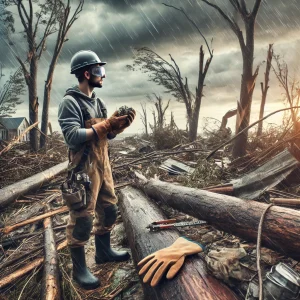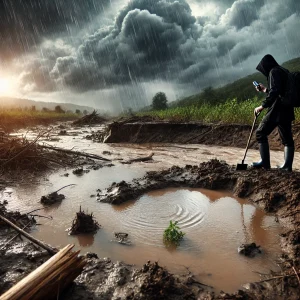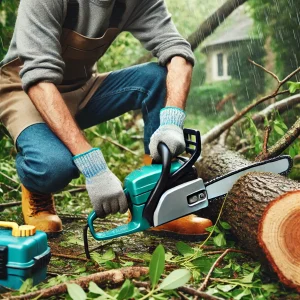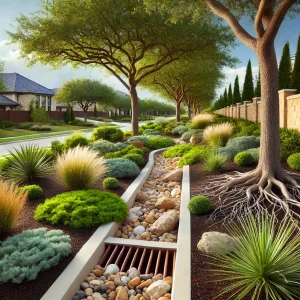After a major storm, such as Hurricane Helene, landscapes are often damaged and need extensive recovery. Whether you’re a professional landscaper or a homeowner, it’s crucial to prioritize safety during post-storm cleanup. This blog covers essential safety tips for short-term recovery and long-term landscape management, highlighting key lessons from Hurricane Helene and offering practical insights for preventing future damage.

Prioritize Personal Safety with Protective Gear
Storm cleanup can expose individuals to hazardous conditions, making proper protective gear essential. Landscapers and homeowners alike should invest in high-quality gear, including:
- Hard hats: To protect against falling branches or debris.
- Protective gloves: For handling sharp objects, debris, and damaged plants.
- Steel-toe boots: Protecting heavy equipment and uneven terrain.
- Safety goggles shield eyes from dust, dirt, and flying debris.
- Hearing protection: Particularly important for those operating loud machinery such as chainsaws or wood chippers.
Following Hurricane Helene, many injuries were reported due to improper protective gear during cleanup. Ensuring you have the right gear can significantly reduce the risk of accidents.

Use Proper Equipment for Safe Tree Removal
One of the most common challenges after a storm is dealing with fallen trees and large branches. Safe tree removal requires the right tools and techniques to prevent injury and property damage. Key tips include:
- Chainsaw safety: Always check the chainsaw for maintenance issues, such as dull blades or oil levels, before use. Never attempt to cut branches above your shoulder height or get tangled in power lines—call a professional for these situations.
- Cutting technique: Use the three-cut method to remove large branches safely. This involves an undercut on the branch about a third of the way through, followed by a second cut from the top to meet the first. Finally, make a third cut to remove the remaining stub.
In the aftermath of Hurricane Helene, numerous accidents were caused by improper tree removal techniques. It’s important to recognize your limits and seek professional help when necessary.

Understand Soil Conditions Post-Storm
Storms like Hurricane Helene can severely disrupt soil conditions, leading to erosion, compaction, or waterlogging. Both landscapers and homeowners should take these factors into account during recovery:
- Avoid working on waterlogged soil: Heavy equipment can compact the soil, causing long-term damage to the landscape’s health. Wait until the soil has dried out before starting any heavy landscaping tasks.
- Regrade if necessary: If the storm caused significant erosion, regrading may be needed to prevent further damage. This involves reshaping the landscape to promote proper water drainage.
In regions affected by Hurricane Helene, the combination of high winds and heavy rains led to widespread soil erosion, which had long-lasting effects on landscape recovery efforts.

Safe Debris Removal
Removing debris after a storm can be physically demanding and hazardous. To stay safe, consider the following:
- Cut large debris into manageable sizes: This helps prevent injury from lifting or dragging heavy materials.
- Watch for hidden hazards: Storm debris can hide sharp objects, live electrical wires, or unstable structures. Always inspect debris carefully before removal.
- Proper disposal: Follow local regulations for disposing of storm debris, such as composting plant materials and arranging for large debris pickup.
During the recovery from Hurricane Helene, many individuals sustained injuries while attempting to move heavy or unstable debris. Taking a cautious approach and using the right tools can make debris removal safer and more efficient.

Plan for Future Storms
While storm recovery is crucial, preparing for future storms can prevent extensive damage. Consider the following long-term strategies:
- Choose wind-resistant plants: Some species are more resilient to high winds and heavy rain. Opt for native plants with deep roots that can better withstand extreme weather.
- Reinforce trees: Proper pruning techniques can reduce the risk of broken branches. Regularly prune trees to remove weak or overgrown branches that could pose a threat during future storms.
- Install proper drainage systems: Waterlogged soil can lead to plant disease and erosion. Installing a drainage system, such as a French drain, can help divert water away from vulnerable areas.
In the wake of Hurricane Helene, many landscapers began focusing on storm-resistant landscape designs to mitigate damage from future weather events. By planning ahead, homeowners and landscapers can minimize the impact of future storms.
Know When to Call a Professional
Post-storm landscaping often involves tasks that exceed the capabilities of homeowners or even experienced landscapers. In cases of large fallen trees, unstable structures, or electrical hazards, it’s important to call a licensed professional.
Following Hurricane Helene, numerous reports of homeowners attempting dangerous repairs led to injuries and further damage. Recognizing when a task is too complex or hazardous is key to maintaining safety during recovery efforts.

Recovering from a storm like Hurricane Helene requires hard work and a commitment to safety. By using proper protective gear, employing the right techniques, and planning for future storms, landscapers and homeowners can manage storm recovery effectively while minimizing risks. Whether dealing with fallen trees, debris, or landscape erosion, always prioritize safety and know when to seek professional help.
By learning from past storms and preparing for future ones, you can protect your property and ensure that your landscape thrives in the long term.